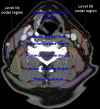Vision 20/20: perspectives on automated image segmentation for radiotherapy
- PMID: 24784366
- PMCID: PMC4000389
- DOI: 10.1118/1.4871620
Vision 20/20: perspectives on automated image segmentation for radiotherapy
Abstract
Due to rapid advances in radiation therapy (RT), especially image guidance and treatment adaptation, a fast and accurate segmentation of medical images is a very important part of the treatment. Manual delineation of target volumes and organs at risk is still the standard routine for most clinics, even though it is time consuming and prone to intra- and interobserver variations. Automated segmentation methods seek to reduce delineation workload and unify the organ boundary definition. In this paper, the authors review the current autosegmentation methods particularly relevant for applications in RT. The authors outline the methods' strengths and limitations and propose strategies that could lead to wider acceptance of autosegmentation in routine clinical practice. The authors conclude that currently, autosegmentation technology in RT planning is an efficient tool for the clinicians to provide them with a good starting point for review and adjustment. Modern hardware platforms including GPUs allow most of the autosegmentation tasks to be done in a range of a few minutes. In the nearest future, improvements in CT-based autosegmentation tools will be achieved through standardization of imaging and contouring protocols. In the longer term, the authors expect a wider use of multimodality approaches and better understanding of correlation of imaging with biology and pathology.
Figures




References
-
- Weszka J. S., “Survey of threshold selection techniques,” Comput. Graphics Image Process. 7, 259–265 (1978).10.1016/0146-664X(78)90116-8 - DOI
-
- Boykov Y. Y. and Jolly M. P., “Interactive graph cuts for optimal boundary and region segmentation of objects in N-D images,” in Proceedings of the Eighth IEEE International Conference on Computer Vision (Vancouver, Canada, 2001), Vol. I, pp. 105–112.
-
- Mangan A. P. and Whitaker R. T., “Partitioning 3D surface meshes using watershed segmentation,” IEEE Trans. Vis. Comput. Graphics 5, 308–321 (1999).10.1109/2945.817348 - DOI
-
- Stawiaski J., Decenciere E., and Bidault F., “Spatio-temporal segmentation for radiotherapy planning,” Math. Ind. 15, 223–228 (2010).10.1007/978-3-642-12110-4 - DOI
Publication types
MeSH terms
Grants and funding
LinkOut - more resources
Full Text Sources
Other Literature Sources

